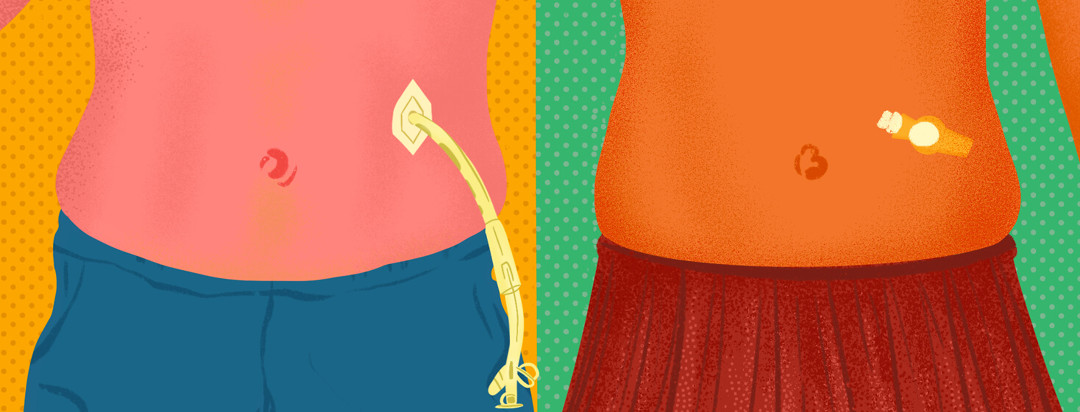Gastrostomy Tubes (G-Tubes) and Cystic Fibrosis
Gaining weight can increase energy and reduce complications for people with cystic fibrosis (CF). However, about 85 percent of people with cystic fibrosis cannot produce the pancreatic enzymes they need to digest and absorb fats, proteins, and starch. People with CF often have a smaller appetite because their lungs may block the stomach from stretching. This often causes people with CF to have vitamin deficiencies that lead to poor growth and poor weight gain.1
If you or your child with cystic fibrosis are struggling to maintain a healthy weight, a gastrostomy tube (G-tube) feeding may help. This is a tube inserted into the stomach to directly deliver nutrition. Inserting a G-tube requires surgery, which may be scary. However, it is a short, common procedure with few complications. Even still, it is good to know what to expect during and after G-tube placement.
How are G-tubes used for cystic fibrosis?
A gastrostomy tube, or G-tube, gives direct access to the stomach. It can be used for feeding, hydration, or medication.2
G-tubes can be used to replace all meals. They are more often used to supplement what you normally eat by mouth. G-tubes last for more than a year before needing to be replaced by a parent, caregiver, or doctor without another surgery.3
You may want to consider a G-tube if you or a loved one with cystic fibrosis:4
- Have a poor appetite
- Experience nausea or vomiting
- Have worsening lung function
- Have difficulty gaining weight
What are the different types of G-tubes?
There are many types of G-tubes for people with cystic fibrosis. Your doctor will determine the best type and explain this in detail. People often use a long tube first and then switch to a button tube.2,5
Long tube
Long tubes are held in place either with stitches or a balloon filled with water. Sometimes, a dressing may be placed around it to help the tube stay in place.2,5
Button tube
This is a “low-profile” tube that lays on top of the abdominal wall. It is held in place in the stomach by a balloon filled with water. An extension is then attached when feeding.2,5
What should I expect during G-tube placement?
Before placement of a G-tube, your doctors may do several tests. You and your family may also meet with specialists to set up a home care plan. Your doctor will tell you when to stop eating and drinking before the procedure.3
When you get to the hospital, your doctor will explain what will happen. You can ask the doctors anything you do not understand. Doctors will monitor your vital signs and begin giving anesthesia. The anesthesia keeps you in a sleep-like state so you do not feel the surgery. You will go to an operating room, and parents or caregivers will go to a waiting room.5
Doctors may perform surgery by making cuts in the belly for the G-tube and a small telescope. Or, they may insert a long tube with a camera through the mouth to guide the G-tube into the stomach.3
The procedure usually takes 30 to 45 minutes. It may then take an hour to wake up from anesthesia. You may feel groggy, confused, or scared when waking up. This is common and improves within 30 to 45 minutes.5
What happens after G-tube placement?
After placement of a G-tube, you may stay in the hospital for 1 to 2 days. A parent can usually stay in the hospital with you. While in the hospital, you will:3
Get pain medicine and antibiotics as needed
- Learn how to care for the tube and the skin around it
- Learn how to handle problems with the tube
- Learn how and what to feed through the tube
Sometimes, you will get a temporary tube that allows the area to heal better. Then 4 to 6 weeks later, it will be changed to a long-term tube.6
After-visit care
By the time you go home after G-tube placement, you will have:5
- Instructions on homecare
- A visit scheduled with a homecare nurse to check on you
- Follow-up visits with your doctor
Complications are rare, but the area around the tube can get infected and irritated. Wash your hands before handling the G-tube and keep the skin around it clean and dry. Call your doctor if you have:5
- A dislodged tube
- A blocked tube
- Signs of infection
- Excessive bleeding or drainage
- Severe belly pain
- Vomiting or diarrhea
- Pink-red tissue coming out from the tube
After you have healed, you will have a few restrictions. If you are concerned about how the tube looks and how others may react, you can meet with a social worker.5 You can also discuss any concerns you have about your G-tube with your cystic fibrosis care team.
After a few months, your doctor may recommend replacing the long tube with a button tube. This often makes feedings and care easier, and can be done without surgery. If you become able to get enough nutrition by mouth, the G-tube can be removed. This does not require surgery, and the small hole will close up on its own.5

Join the conversation